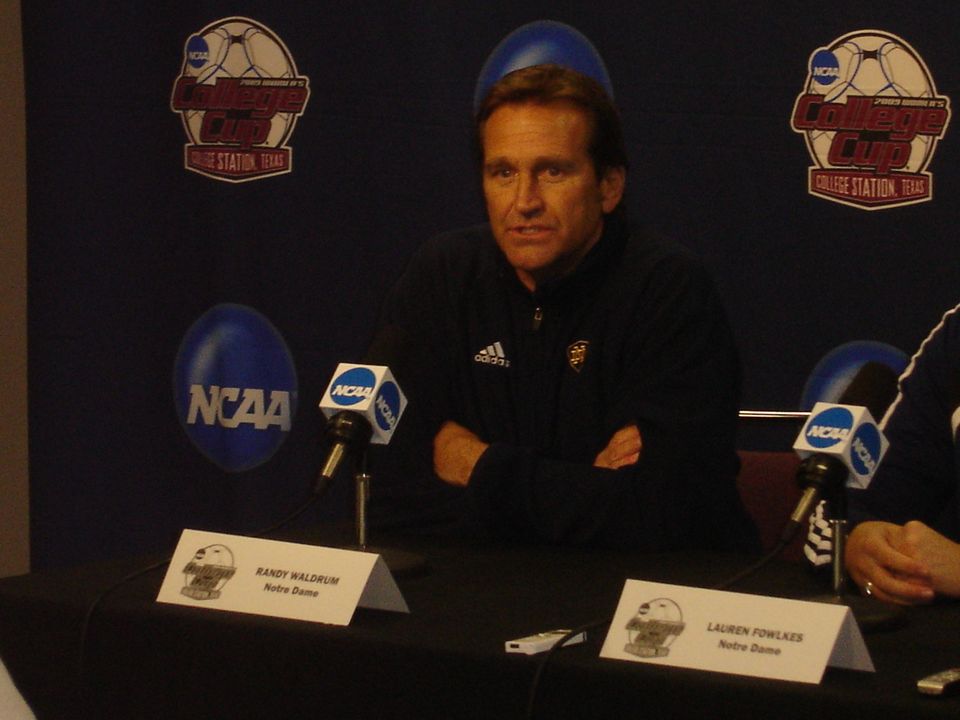Aug. 19, 2010
EDITOR’S NOTE: This is the first in a five-part series on UND.com, spotlighting the 2010 Notre Dame fall sports season with both written and video previews. Today, we take a look at the Fighting Irish women’s soccer team, which has advanced to the NCAA Women’s College Cup each of the past four seasons and five times in the past six years.
For every college soccer team, the four-month journey between the starting of training camp and the final whistle at the NCAA Women’s College Cup is a demanding one. It’s a daily test of each player’s strength, endurance, commitment and discipline that ultimately separates the championship-caliber teams from those whose title hopes are pure fiction.
This rugged journey is one that Notre Dame knows well, having made 11 trips to the College Cup, including December runs in each of the past four seasons (and five of the past six). The Fighting Irish also understand what it means to find the pot of gold at the end of that long rainbow, having won a pair of national championships as part of seven visits to the NCAA title match.
Few coaches are as intimately familiar with the challenges needed to navigate the college soccer season as Notre Dame’s Randy Waldrum. The 12th-year skipper has been at the helm for seven of those Fighting Irish College Cup berths, as well as four trips to the NCAA title contest and the 2004 national championship. Along the way, he’s also skillfully piloted Notre Dame to 10 BIG EAST Conference regular-season titles (not to mention the past seven) and seven BIG EAST tournament crowns, including four in the past five years (a string interrupted only by a penalty-kick shootout loss in 2007).
Since Waldrum arrived in South Bend in 1999, his Fighting Irish teams have experienced just about every possible challenge on their annual quest for championship hardware. Yet, they have rarely wavered along this road, often navigating through the roadblocks, detours and hairpin turns that have been thrown in their path. It’s that resolve, that fortitude, and that determination in the face of adversity that have consistently made Notre Dame one of the nation’s elite programs.
The 2009 season was a prime example of how the Fighting Irish persevered and succeeded when the odds seemed long. During the preseason, Notre Dame was faced with injuries to several critical contributors, most notably senior tri-captains Courtney Rosen, an ’08 all-region selection who missed the entire season with a broken foot, and Michele Weissenhofer, the ’06 Soccer America National Freshman of the Year who played in barely half (14) of her team’s matches last season and averaged fewer than 40 minutes per night due to a myriad of recurring leg injuries. Between them, the duo had accounted for 104 starts, 36 goals and 112 points in their first three seasons.
Couple those injuries (as well as chronic maladies for veteran center back Haley Ford and a slow recovery from off-season leg surgery by high-scoring forward and ’08 first-team freshman All-American Melissa Henderson) with an arduous non-conference schedule that included matches with fellow national powers North Carolina, Stanford and Santa Clara (the latter two on the road), and it left Notre Dame with a 3-3-0 record through the season’s first six contests, and standing at a crossroads in its campaign.
However, with Waldrum’s GPS-like knowledge of the college soccer landscape, the Fighting Irish were able to get their annual caravan to the College Cup back on course, thanks to a clever use of personnel, most notably moving Lauren Fowlkes from her traditional center back and holding midfield position to a forward spot, where she enjoyed the finest season of her career. The complementing shift of Courtney Barg to the role of holding midfielder also seemed to put a tiger in Notre Dame’s tank, as the Fighting Irish went on a 19-match unbeaten streak (18-0-1) during the season’s final two months, outscoring the opposition, 50-7 and posting 13 shutouts in that span.
“With the slow start you always worry that the season is going to go south really fast, so I give credit to the kids and even to the staff,” Waldrum said. “They did a good job of holding things together early. It took us a couple of weeks to recover, but we got it turned around and made some changes along the way. I think moving Lauren Fowlkes up front, (and) solidifying what we needed up there a little bit, especially with Melissa (Henderson) coming off the surgeries in the summer, she wasn’t quite ready early on in the year. I thought that move really was a big move for us. Looking at the season in general, that’s probably one of the more rewarding years I have had in the 11 years here because it was such a bad start and then to come back and make it to the College Cup.”
As the 2010 season unfolds, Notre Dame appears to have many of the tools necessary to handle any challenges that come its way. The Fighting Irish bring back 16 monogram winners, including nine of 11 starters from last year’s squad, while sprinkling in a talented group of eight newcomers that ranks among the nation’s top incoming classes. What’s more, Notre Dame returns better than 85 percent of its offensive production, as well as three-fourths of a starting backline (and the starting goalkeeper) that was critical to the team’s late-season defensive success.
“I don’t think you say enough about having veteran players on your team,” Waldrum commented. “This group that we have now, most have gone through the ’08 year that was smooth sailing and everything fell into place and it was just an `enjoy-the-ride’ year. Then, they went through last year where they had to fight and scratch for everything. There were a lot of those games that could have gone the other way and made that a completely different season. I think you need players to go through some of those times to be good.
“I like the experience that’s coming back,” he continued. “Coaches always like to talk about experience, but you’ve got to do something with it, too. It’s going to be key with the chemistry and how that all fits together. It’s always interesting when you have freshmen and displace a couple of the older players that have been there. But, it seems like a group that is pretty together and that excites me and reminds me more of 2008.”
While no one can accurately predict what direction each season will take, it’s evident the Fighting Irish understand the road map to success like few other programs in the country.
Here’s a position-by-position breakdown of the Notre Dame roster for 2010:
FORWARDS
It may have taken a little while to develop, but the Fighting Irish wound up with one of the nation’s top five goalscoring duos last season, as the “thunder and lightning” combination of Fowlkes (thunder) and Henderson (lightning) collectively found the back of the net 28 times a year ago. Both halves of that potent tandem return this season, along with senior Taylor Knaack, who led the BIG EAST in goals during conference play, giving Notre Dame a strong front-line crew that can match up with the some of the nation’s premier offensive units.
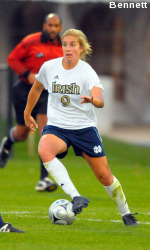
Senior All-American and co-captain Lauren Fowlkes is one of the most versatile players in the country, and is coming off an outstanding offensive campaign in 2009 when she posted career highs of 10 goals and four assists.
|
Fowlkes, who has achieved great success at all three field positions (forward, midfielder, defender) during her career, was a National Soccer Coaches Association of America (NSCAA) third-team All-America selection last season after ranking among the BIG EAST leaders with career highs for goals (10), points (24), gamewinning goals (3), shots (team-high 79) and shots on goal (33). The BIG EAST Co-Offensive Player of the Year and BIG EAST Championship Most Outstanding Offensive Player, Fowlkes also boasts extensive international experience as a starter on the United States U-20 Team that earned the gold medal at the 2008 FIFA U-20 World Cup, and currently with the USA U-23 squad.
As if that weren’t enough, Fowlkes has proven to be a standout in the classroom, collecting ESPN The Magazine second-team Academic All-America honors last year to become the 52nd Notre Dame student-athlete (and the fourth women’s soccer player) to pair athletic and academic All-America accolades in the same season. Were she to pull off that double again this season, she would become only the 13th Fighting Irish student-athlete to do so twice in her career, joining the likes of Notre Dame women’s soccer greats Jen Renola (1995-96) and Brittany Bock (2007-08) in that illustrious company.
One of the nation’s most versatile players and a top candidate for the Hermann Trophy and Lowe’s Senior CLASSâ⒬ˆAward in 2010, Fowlkes also could revert to her former role as a center back, depending on how other position battles pan out. Noted for her physical prowess, both in the air and with her back to goal, the 5-foot-10 senior from Lee’s Summit, Mo., combines size with poise, solid playmaking and excellent leadership skills, the latter of which undoubtedly led to her selection as a team co-captain via a preseason vote of her teammates.
“Everyone (around the country) knows about Lauren, so I don’t think she will be a surprise to anyone,” Waldrum said. “It’s just a matter of what we are going to do with her. No matter where she’s played, she has just been such a steady player for us ever since she got here. She has got everything, the size, the strength, she is good with the ball, I think she reads the game well and she is committed. The good thing though is that she reads the game so well and she doesn’t get caught. She is kind of like (2008 All-American and now WPS veteran) Carrie Dew in that regard. Carrie wasn’t the fastest player but you rarely saw her get outrun. She reads the game and she is a good position all the time and Lauren reminds me of that.”
Henderson got off to a slow start last year while recovering from her preseason leg surgery, but by the end of the 2009 campaign, there were few forwards in the country who could match her production. A Soccer America first-team MVP selection (equivalent to All-America honors), as well as a first-team all-region and second-team all-BIG EAST choice, Henderson led the conference and set new career highs for goals (18), points (41) and gamewinning goals (school-record 9). She also enjoyed one of the finest individual postseason runs in program history, setting school records for goals (10), gamewinning goals (4), gamewinning points (10) and hat tricks (2), highlighted by a school record-tying four goals against Central Michigan in the second round of the NCAA Championship.
Like Fowlkes, Henderson is a current member of the U.S. U-23 National Team player pool and was named to the 2010 Hermann Trophy watch list. A skilled technical player whose creativity on the ball and finishing skills are virtually unmatched, she also boasts speed and athleticism that put tremendous pressure on opposing defenses. What’s more, the Garland, Texas, junior has polished her playmaking abilities, opening up numerous opportunities for her teammates.
“I don’t think she realizes how good she really is,” Waldrum noted. “She is quick to deflect things to everyone else and sometimes you just want to say `get a little bit selfish here and do it.’ If she has the kind of year that we know she is capable of having, I think this could be a breakout year for her. That is has hard to say because she scores 17 to 18 goals a year for you in the first two years and most people around the country would die for those kinds of stats. I really think she is one of those that can be like (two-time Hermann Trophy recipient Kerri) Hanks and get you 20 to 25 goals in a season. I don’t think it is that difficult to do so I am looking forward to seeing how she is going to be this year.”
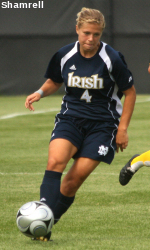
Senior forward Taylor Knaack was one of the most improved players in the country last season, leading the BIG EAST with six goals during conference play.
|
Knaack was arguably one of the most improved players on the Notre Dame roster last season, posting career highs with six goals (including three gamewinners), five assists, 17 points and 43 shots (20 on goal), all of which ranked among the top four on the team. In addition, she experienced great success during the BIG EAST regular season, leading the conference with all six of her goals and three of her five assists against league foes.
A speedy forward who also could be called upon to fill in as an attacking midfielder on occasion, Knaack is a tenacious competitor who can wear down the oppostion with her on-ball pressure. Likewise, she is effective in the open field and stretches defenses with her quickness and flair in the offensive third, giving Notre Dame another reliable scoring presence to fill out the Fighting Irish starting front line.
“What I am seeing with her is a change in everything about her, not just her playing, but she is maturing a little bit,” Waldrum stated. “She is always that player that can live on the edge a little and you always worried about. In the last year I have really seen her grow a lot in that regard and I think she is finally getting it. She is getting that taste that she doesn’t have many more chances to do this. It was the first time we saw her spending time before and after practice working on her game and that is what we saw on the field last year, which was her best year ever. She has the speed, she is fit, she is mobile, she can score enough goals for you, she can create, and she is not an easy player to defend against because she is all over the place. So I hope she comes in ready do to that again.”
Another veteran who could offer significant contributions up top for Notre Dame this season is senior Erica Iantorno. A versatile forward who also may see time in the midfield, Iantorno has been one of the top Fighting Irish reserves throughout her career, appearing in 72 of 79 contests during her first three seasons, including all but one in the past two years. The Hinsdale, Ill., native turned in a career year in 2008 (five goals, seven assists, 17 points) before adding three goals and an assist last season despite playing the entire year with a bulky cast on her broken right wrist.
A hard-working player whose has proven to be a solid complementary piece in the Notre Dame offensive puzzle, Iantorno will be counted on to add veteran depth and leadership to the Fighting Irish roster this season.
“She had a really good year coming off the bench two years ago,” Waldrum observed. “Last year, it was very inconsistent. If she can get the consistency back, she has got an opportunity to step in and start for us. She is good enough to do it but I think she is going to be in a battle. The good thing about Erica is there is not much of a change in the level of effort or intensity when you put her in — it doesn’t drop much at all.”
Other players with the potential to be offensive threats for Notre Dame this year include sophomore Lindsay Brown and freshman Adriana Leon.
Brown appeared in 14 games for the Fighting Irish as a rookie, playing primarily in the midfield (a role she may also reprise at times this season). The Newport Beach, Calif., native is a cagey attacker with strength on either foot, in addition to being a solid distributor during the run of play and on set pieces.
Meanwhile, a member of the Canadian Under-20 National Team, Leon was Canada’s top scorer during round-robin play at the 2010 CONCACAF U-20 World Cup Qualifying Tournament. Also a talented youth hockey player, she blends hard-nosed intensity with athleticism and a scorer’s mentality that should give the Fighting Irish further punch on the front line.
MIDFIELDERS
As many coaches point out, the success of any soccer team is based on strong play in the midfield, and Notre Dame has two of the best midfielders in the country in senior Rose Augustin and junior Courtney Barg. Add in the possibility of Fowlkes seeing time on the mid-line, as well as a handful of other talented veterans who will look to battle their way into the starting XI and you have the makings of a strong power plant to fuel the Fighting Irish system.
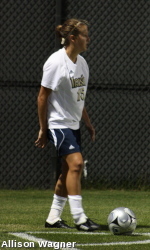
Senior midfielder Rose Augustin has proven to be a dangerous offensive weapon for the Fighting Irish, leading the team with 10 assists last season.
|
Augustin is, without question, one of the most underrated players in college soccer, despite earning second-team all-region and all-BIG EAST recognition a year ago. The Silver Lake, Ohio, native started all but one match last season, turning in career highs with seven goals, a team-best 10 assists, 24 points and 76 shots. She also has proven to be a dependable threat in the postseason, scoring five career goals in the NCAA Championship (including the gamewinner in last year’s third-round win over Oregon State) and also assisting on Ford’s clinching score at Florida State in the ’09 NCAA quarterfinals.
Boasting one of the strongest shots on the team with great effectiveness off either foot, Augustin’s biggest contributions have come on set pieces, where she has shown an uncanny ability to deliver pinpoint services from either free kicks or the corner flag. She also is a very cerebral player with a firm grasp of strategy and tactics.
“Rose was one of those who had a great year for us last year,” Waldrum said. “It was a little disappointing that she did not get a little more recognition than she did. She is such a good player and she has taken on some leadership on the field, especially in the Carolina (regular-season) game when she was the one that was still going strong the full 90 minutes. That kind of showed us what she was going to be like the rest of year. She has all the tools to be someone that could be really special for us, too. When you have a program like ours and you start going down the list, you have Barg, you’ve got Fowlkes, you’ve got Henderson, you’ve got (Jessica) Schuveiller, and you’ve got Rose. Sometimes, good players can get lost in the mix because there are so many other good players. I really think she will be a key for us this year.”
Barg is one of the nation’s elite rising stars after her full-time move to the holding midfield position. A first-team NSCAA All-American last season, the Plano, Texas, resident started all 26 matches for Notre Dame, logging a goal and two assists. Yet, it was her composure on the ball, superb technical skills, exceptional vision and creativity that made her not only a Hermann Trophy semifinalist, but the BIG EAST Midfielder of the Year and a member of the NCAA College Cup and BIG EAST all-tournament teams.
The potential exists for Barg to achieve even greater things this season, as she not only is a prime candidate for the Hermann Trophy, but also is on the radar for Academic All-America honors through her work as an accounting major in Notre Dame’s Mendoza College of Business.
“To me, Courtney is one of the best players in the country,” Waldrum said. “She’s probably been one of the better players we have ever had in this program and it was nice to finally see her get appreciated last year because, in her freshmen year (2008), I thought she was very good for us, but you are overshadowed when you have Dew, Hanks and Bock and all those players that had two or three years of gaining that reputation. It was nice to see Courtney get rewarded for that last year.
“I would be shocked if she didn’t have another year like that,” he added. “I will be disappointed if she isn’t in the picture for the Hermann at the end of the year. Getting her back, she is kind of the key to how we play. She runs the show in midfield for us. I don’t see that changing for her at all. I would have like to have had her at summer school at a different time because I think she would have been with the (United States) U-23s when they went to England in July for the Four Nations Tournament. I know they wanted her in camp, but unfortunately she was studying abroad. But, I think she will get her time because she is one that has that kind of future. It will be hard to not see her on our senior women’s national team in the years to come — she is that good.”
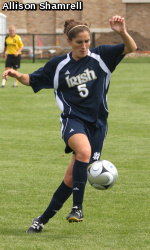
Junior Molly Campbell is a versatile contributor to the Notre Dame lineup as both a midfielder and defender, having started all 26 games last season.
|
Versatility is a key to Notre Dame’s success through the years, and the midfield could see the greatest infusion of that multi-faceted talent for the Fighting Irish this season. In addition to Fowlkes, Knaack, Iantorno and Brown potentially fitting into the midfield at various times, junior Molly Campbell could migrate up from the left back spot, where she started all 26 matches last season, collecting a goal and career-high three assists on 25 shots.
One of the team’s fittest players, Campbell has good technical ability on the ball and is very mobile, which allows her to fit well into the Fighting Irish system at either end. In addition, she shows great intelligence on the pitch, giving her the knowledge base to play multiple positions, and is an accomplished student-athlete off the pitch, garnering ESPN The Magazine first-team Academic All-District V honors last year during her work as a political science major in Notre Dame’ College of Arts and Letters.
Juniors Ellen Jantsch and Brynn Gerstle, as well as freshmen Mandy Laddish and Elizabeth Tucker also could compete for playing time in the midfield this season. Jantsch played in 16 matches last season, scoring a pair of goals, and has shown promise as both a holding midfielder and a center back. She also is a physical presence in the center of the pitch who has utilized her 5-foot-9 frame to excel in the air.
“You are going to need someone like an Ellen Jantsch to kind of do the kind of things that Amanda Clark did for us last year,” Waldrum commented. “There are going to be the games where you need somebody to bang those bodies and just be disruptive and be good defensively and that is what she does well. It is going to be a key year for her.”
Gerstle was one of the team’s most improved players during the spring 2010 season, playing primarily in the defensive third. The lanky, athletic midfielder offers size (also 5-foot-9) and mobility, along with a strong leg, all of which could make her a contributor on set pieces.
“She is going to be like Ellen,” Waldrum noted. “She’s got a chance now. She proved to us in the spring she probably deserves a little more time than I have given her in the past and her confidence has started to come around a little bit. She is going to be in that mix. With us playing three in the midfield, you usually need five or six midfield players to play in those three spots to keep it going. She will be in the hunt to get some time there.”
Laddish was a consensus high school All-America selection as a prep senior in 2009, having piled up double-digit goals and assists (total of 36 goals and 40 assists) in her final two seasons at Lee’s Summit (Mo.) High School. She also has blossomed into a key figure in the U.S. Soccer youth national team player pools, first as a starter for the 2008 USA U-17 National Team that earned the silver medal at the inaugural FIFA U-17 World Cup in New Zealand, and more recently with the United States U-18 and U-20 teams.
A well-conditioned, feisty attacking player, Tucker was a three-sport standout at Bishop Kenny High School in Jacksonville, Fla., and also achieved success on the soccer pitch as a Region III ODP player along with her time playing for the Jacksonville Fury club program.
DEFENDERS
One of the critical reasons for Notre Dame’s unbeaten streak and turnaround during the final two months of last season was the stability that developed on the Fighting Irish back line. Two of the key components on that line — junior center back/co-captain Jessica Schuveiller and senior right back Julie Scheidler — are penciled in to hold down those same spots again this season, while Fowlkes ideally would be moved into the other center back spot with Ford’s graduation.
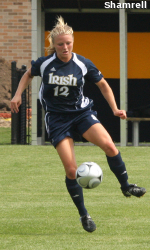
Junior co-captain Jessica Schuveiller has been one of the anchors on the Notre Dame back line the past two seasons, starting all 53 games in her career and helping the Fighting Irish record 34 shutouts in that span.
|
Schuveiller is a second-year captain after being voted as the first non-senior captain for the Fighting Irish since 2002 (Amy Warner). A tough, tenacious leader with an excellent understanding of defensive positioning and strategy, the Plano, Texas, native has started all 53 games in her first two seasons at Notre Dame, helping post 34 shutouts in that span while learning from such talented greats as Ford and All-American Carrie Dew (now with FC Gold Pride in Women’s Professional Soccer).
An up-and-coming contributor on the U.S. Under-23 National Team player pool, Schuveiller was a second-team all-region and first-team all-BIG EAST selection last season, in addition to earning the BIG EAST Championship Most Outstanding Defensive Player award while leading Notre Dame to the conference title. She also continued her incredible knack for scoring clutch goals, netting the gamewinning tallies at Cincinnati (2-1) in the regular season and against St. John’s (2-1) in overtime in the BIG EAST Championship semifinals, after potting her first career goal to open the Fighting Irish account in the 2008 NCAA quarterfinal at home against Florida State (won by Notre Dame, 2-0).
“Jess is another one that really just starting to get a little bit of the national accolades,” Waldrum said. “She is one of the best backs in the country. She does all the dirty work and yet she is good with the ball. What we would like to see her do is to control the ball offensively more than she does. She has two years now of just worrying about making sure the defensive part is right and now we will see her take off a little bit more on the attacking end. Hopefully, the experience with the U23s this summer is only going to help her confidence. She is a great player and to me, she is an All-American as well. I hope that she gets some of that notice this year and people will start to take a little more notice of her this year once we start the season. She is one that you have to keep an eye on.”
Scheidler similarly has proven to be a dependable defensive starter for the Fighting Irish throughout her career, appearing in all 79 matches and starting 69 times in her first three seasons under the Golden Dome. With a blend of athleticism and quickness, the Indianapolis resident also has proven to be a dangerous offensive threat on the wings, leading all Notre Dame backs with nine assists in the past two years combined, and even scoring her first career goal last season against Northwestern.
“When Julie got here as a freshman, you thought she would be a good utility player,” Waldrum commented. “She would be someone that would get some time, but I had no expectation of her having the kind of career she has had. The good thing about her is that she has gotten better every year and just keeps doing what she does best. She is confident and she doesn’t have any doubts. She also has improved the attacking side of her game year after year.”
Fowlkes and Campbell will have the inside track on the other center back position alongside Schuveiller. However, one dark-horse candidate for that starting spot could be junior Ellen Bartindale, who last season turned out to be the textbook example of a player being prepared and ready to compete when her number called. When Ford and Jazmin Hall went down with injuries in consecutive matches in mid-October, Bartindale (who had played in only four contests as a freshman) was thrust into the starting lineup and showed great poise and maturity, helping Notre Dame to four consecutive shutouts at the end of the regular season and on into the BIG EAST Championship. She also played every minute in four of five matches during that stretch, including all 99 minutes in the BIG EAST semifinal win in extra time over St. John’s.
“In a lot of way, Ellen probably was a key to a really good run for us through the BIG EAST,” Waldrum stated. “She did a really good job for us until we could get some players back. Not only did it built her confidence in her ability to step in and compete, but it also built our confidence (as coaches) in her to see that she can go in and she can handle most of the situations that she was thrown in to. So that is really going to bode well for her this year.”
With Campbell moving primarily to either a midfield or center back role, Hall and freshman Kecia Morway will compete for the starting spot at the left back position.
Hall was Notre Dame’s top rookie last season, appearing in 20 matches and starting eight times despite missing the latter half of the regular season with a leg injury. Yet another member of the Fighting Irish contingent from Texas, Hall plays much bigger than her 5-foot-3 size would indicate, thanks to her physical play and acute awareness of defensive positioning. What’s more, she also blended seamlessly into the Notre Dame system with her timely runs in to the offensive third and strong service game from the flanks.
Meanwhile, Morway was a 2009 NSCAA Youth All-America selection and a two-time NSCAA youth all-region honoree during her time playing for the high-powered Eclipse Select club program that has produced such recent Fighting Irish greats as Bock, Weissenhofer and 2009 graduate (and second-year WPS player) Elise Weber. Morrow is a scrappy outside back with a bulldog mentality and a championship pedigree, having helped Eclipse to three consecutive national finals appearances at the U.S. Youth Soccer (USYS) Championships, including a U-17 title in 2009.
GOALKEEPERS
If the stability on the Notre Dame back line was one component of the team’s late-season surge in 2009, then another contributor to that streak was the emergence of goalkeeper Nikki Weiss.
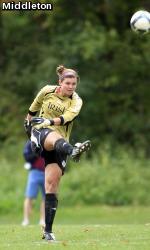
Senior goalkeeper Nikki Weiss set a BIG EAST record last season with a 0.15 goals-against average (GAA) in regular-season conference play.
|
The Redding, Conn., senior had played in only 16 matches (starting three times) in her first two seasons for the Fighting Irish, but she superbly tended goal 19 times last year, making 17 starts and posting a 14-2-1 record with a 0.51 goals-against average (GAA) and 12 shutouts (seven solo, five combined). She also set a new BIG EAST record with a 0.15 GAA in regular-season play, allowing just one goal in 597 minutes of action while notching five shutouts and eventually earned a place on the BIG EAST All-Tournament Team.
Standing 5-foot-11, Weiss has worked hard to use her physique and become a commanding presence in the penalty area. That was never more evident than in last year’s NCAA quarterfinal at Florida State, when she made five saves and expertly locked down every Seminoles’ offensive threat, and in the College Cup semifinal loss to North Carolina, when she kept the Tar Heels off the board until the final eight minutes while logging a career-high six saves. All told, she posted a 0.38 GAA and .913 save percentage with two solo shutouts and a shared clean sheet in the 2009 NCAA Championship.
“With Nikki, her problem in the first couple of years was she had very little consistency and her confidence was really low,” Waldrum said. “Last year, she put a little more time into her fitness over the summer and came in a little more fit and when she got her shot, she took advantage of it. Now, she is confident and she gets it, so hopefully she’ll be able to carry that over this year.”
Sophomore Maddie Fox will push Weiss for playing time in the Notre Dame goal this season. The San Jose, Calif., resident saw limited action last year, appearing in five matches for a total of 73:14, making two saves and closing out three shutouts for the Fighting Irish. A superb technical netminder with quick reflexes and good instincts, Fox also possesses a strong leg and is fearless in traffic, both in the air and through scrambles in the goal mouth.
“The thing Maddie has that is a little different (than Nikki) is she is probably a little better at shot stopping,” Waldrum noted. “She is a little quicker, her reactions are a little bit better, so shots that are a little lower, she is more athletic and quicker to get to.
“You almost wish you had the best of both (goalkeepers) to put into one,” he added. “They both are completely different in that regard and unfortunately, in the college game, more things happen off of crosses and services into the box. Particularly with the defense that we have, it is not often they get a ton of shots that are just reaction and short-range shots. They are both pretty good on breakaway situations, so the key is going to be who best dominates in the air. It is not that Maddie can’t do it, but Nikki has some size on her and if Nikki is consistent, then she is going to be hard to beat.”
— ND —







